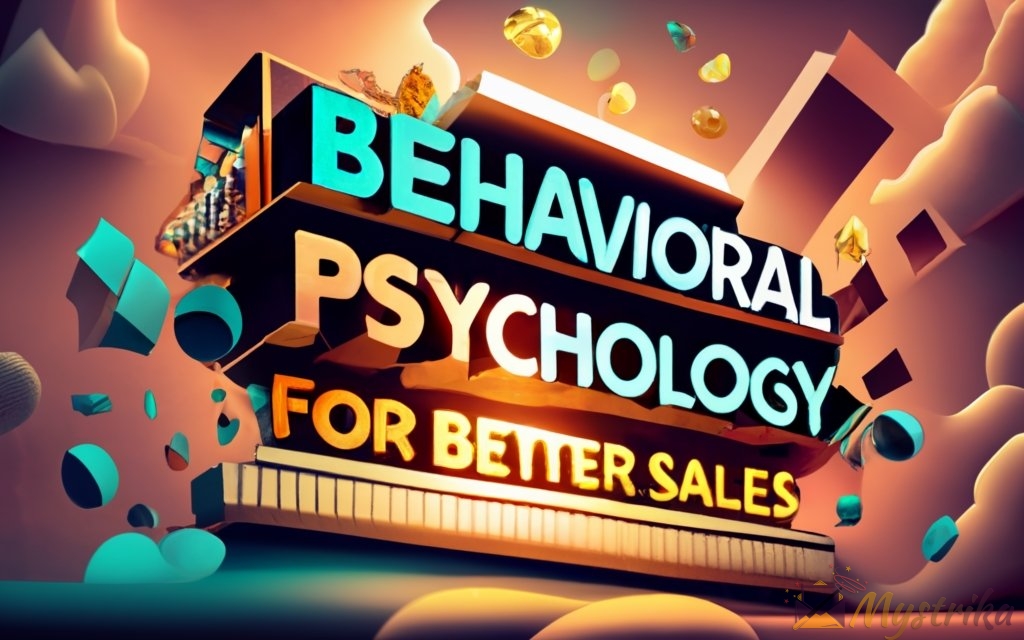Have you ever wondered why certain sales tactics seem so effective, while others fall flat? The secret lies in behavioral psychology. Understanding the hidden biases and mental shortcuts that influence our decisions provides the key to ethically guiding buyers towards smart choices.
Whether you’re in sales, marketing, consulting, or any profession where persuasion and influence matter, leveraging psychology is essential for success. This comprehensive guide will teach you evidence-based techniques to improve your results.
You’ll learn key principles like reciprocation, social proof, authority, unity, scarcity, and more. We’ll cover real-world examples of applying them, along with an action plan framework to integrate them into your sales process. Read on to unlock the psychology of selling, ethically and effectively.
An Introduction to Behavioral Psychology Concepts in Sales
Behavioral psychology is the study of human behavior and decision making. It focuses on how psychological, cognitive, and emotional factors influence actions and choices. In a business context, behavioral psychology provides powerful insights that can be applied to improve sales performance. Let’s explore some key concepts.
What is behavioral psychology and how does it relate to sales?
Behavioral psychology emerged in the early 20th century in contrast to Freud’s psychoanalysis. Instead of focusing on the subconscious, it took a more scientific approach to observing how external stimuli affected behavior. Researchers discovered predictable patterns of human decision making that were contrary to the assumptions of classical economics.
These insights laid the foundation for rethinking sales strategies. Rather than viewing buyers as completely rational actors, behavioral psychology revealed how emotions and mental shortcuts shape purchasing behavior. Sales professionals could leverage this knowledge to ethically guide prospect decisions.
Some key findings relevant to selling include:
- Buyers are susceptible to certain cognitive biases unconsciously. These mental shortcuts can be addressed with awareness.
- People have an innate desire for reciprocity, social proof, authority, scarcity, and unity. Sales tactics can ethically tap into these needs.
- Positive and negative emotional states profoundly impact willingness to buy. Establishing rapport and trust mitigates fear.
- Prospects anchor to initial perceived value. Framing the offering advantageously early is key.
So in summary, behavioral psychology offers research-backed techniques to influence buyer decisions and mutually guide them to the best choice.
Key principles of behavioral psychology relevant to sales
There are several major concepts and mental shortcuts studied in behavioral psychology:
- Reciprocity – People tend to return favors and gifts. Generosity can prompt future reciprocity.
- Social proof – Individuals look to others for behavioral cues. People are heavily influenced by what others do.
- Authority – Displays of expertise and credibility elicit compliance. Being a known authority can confer persuasive influence.
- Scarcity – Opportunities seem more valuable when availability is limited. Scarcity indicates desirability.
- Liking – We are more receptive to those we know and like. Developing affinity builds sales relationships.
- Anchoring – Initial exposure to a number anchors perception. First price impressions matter.
- Availability – Easily recalled data feels more prominent. What’s top of mind seems more important.
There are certainly more mental shortcuts and principles, but these tend to be most relevant and impactful on sales interactions. Keep them in mind as you read on.
Understanding cognitive biases and mental shortcuts
Behavioral psychology has identified many systematic ways that human judgment deviates from purely rational modes of thinking. These “cognitive biases” are wired-in mental shortcuts our brains use to quickly process information. Being aware of them is key.
For example, here are five common biases to understand:
- Confirmation bias – Seeking and interpreting info that aligns with existing beliefs.
- Anchoring bias – Over-relying on an initial reference point when making decisions.
- Availability bias – Estimating probability based on how easily an example comes to mind.
- Bandwagon effect – Taking actions based on what others are doing.
- Survivorship bias – Focusing on examples of success while overlooking failures.
These unconscious filters shape how prospects evaluate information and offers. By addressing them in your sales process, you can guide buyers to more optimal rational conclusions.
Now that we’ve covered a high-level overview of behavioral psychology and its connection to persuasion, let’s get into practical application…
In short, this introduction covered:
- The emergence of behavioral psychology and its alternative view of human decision making
- Major principles like reciprocity and scarcity that influence buyer behavior
- How cognitive biases and mental shortcuts irrationally shape choices
- Why sales professionals should understand these psychological phenomena
Equipped with this foundation, we can now explore specific sales strategies informed by behavioral research to ethically “nudge” prospects toward more rational purchase decisions.

Using Reciprocation and Social Proof to Increase Sales
Two powerful principles of influence in behavioral psychology are reciprocation and social proof. Skillfully and ethically applying these concepts can create a huge sales advantage. Let’s break down how to leverage them.
The principle of reciprocity
Reciprocation is the tendency to respond to a positive action with another positive action. When someone does something nice for us, we instinctively want to return the favor. Sales professionals can use this to mutually benefit buyers.
Robert Cialdini’s seminal book Influence: The Psychology of Persuasion shared the story of a restaurant doubling revenue by giving patrons one free glass of juice at the start of their meal. Even without telling customers, this small gift made them more likely to purchase appetizers, desserts, and return again. They felt inclined to reciprocate the generosity.
This deep-seated quid pro quo ethic can be used ethically in business. By providing value upfront without explicitly requiring reciprocity, you make prospects more open to a purchase. Here are some examples:
- Send a relevant article or analysis with useful insights
- Alert them to a new product feature that solves a pain point
- Introduce them to someone influential who could help their business
- Provide thoughtful feedback and ideas on their website
- Offer free trial access to your software for a month
The key is giving value freely, without asking for anything immediately in return. Done right, this facilitates reciprocity down the line.
Generating reciprocity by providing value first
Here are some best practices for leveraging reciprocity ethically:
- Make sure gifts are meaningful and relevant. Generic gestures won’t have an impact.
- Don’t explicitly require reciprocity. It should happen voluntarily.
- Follow up later to remind them of the value you provided.
- When you finally make your sales ask, reference the earlier gift.
- Frame your offer as an opportunity to reciprocate your help.
- Be patient. Reciprocity may take time to develop, but compounds.
With this approach, prospects never feel manipulated or resentful. Instead, they recognize your generosity as deserving reciprocation. This mutual mindset makes sales interactions smooth and mutually beneficial.
Social proof and its influence on buyer decisions
Social proof refers to people’s tendency to align their behavior with what others are doing. This herd mentality gives us cues for how to act in unfamiliar situations.
In sales contexts, social proof is immensely influential. According to Nielsen, 92% of consumers trust recommendations from friends and family above all other forms of advertising. Even anonymous reviews from strangers shape what we buy.
Positive social cues such as testimonials, referrals, and case studies can thus be very persuasive:
- Testimonials highlight others’ positive experiences using your product.
- Referrals mean an existing customer proactively vouched for you.
- Case studies showcase your offering solving problems for real clients.
- Reviews signal others purchased and were satisfied.
- Media features show third-party endorsement and authority.
We see these as “proof” because others demonstrated positive outcomes already. If it worked for them, it can work for us too.
Ways to incorporate social proof in your sales process
With an understanding of social proof’s power, here are some ways to implement it:
- Collect testimonials: Proactively reach out to satisfied users and gather positive feedback.
- Publish case studies: Write up detailed examples of delivering results for named clients.
- Promote reviews: Monitor sites with user reviews and respond professionally to them.
- Offer referrals: Incentivize existing customers to refer their network.
- Highlight media: Secure and showcase media features on your company.
- Advertise traction: Where relevant, advertise your large user base or sales volumes.
- Namedrop clients: Referencing big-name clients you work with promotes credibility.
The more positive reinforcement you can highlight from others, the more prospects will trust you. But ensure proof points are relevant and honest.
In nutshell, this section explained:
- The enormous influence of reciprocation and social proof on buyer decisions
- How to ethically provide value to generate reciprocity from prospects
- Different forms of credible social proof that boost your authority
- Tactics to actively accumulate and showcase social proof and reciprocity
When woven into your sales process, these behavior psychology principles can make a night-and-day difference in winning over customers.

Motivating Action through Scarcity and Unity
The principles of scarcity and unity are also important for motivating prospect action. While often misused, when applied ethically they can accelerate sales.
Scarcity creates urgency and boosts desire
Scarcity in behavioral psychology refers to the perception that something is rare or becoming unavailable. We assign more value to scarce things.
For example, exclusive clubs prey on scarcity and status by rejecting many applicants. And “limited edition” product drops manufacture scarcity deliberately.
Research shows that scarcity works by generating:
- Reactance – When freedom is threatened from unavailability, we react against it.
- Competition – People compete more for scarce resources they desire.
- Anticipated regret – The fear of missing out on scarce opportunities motivates action.
- Distinctiveness – Owning something rare confers special status.
Savvy sales professionals thus hint at dwindling availability to nudge hurried action. Tactics include:
- Restricted-time discounts or special perks for early adopters
- Limits on supply or availability
- Deadlines on offers or access
- Exclusive deals for top tier customers only
- Premier status for those who act fast
While scarcity powerfully motivates action, it must be used carefully and ethically. Time restrictions should be real, not invented just to pressure buyers. Make sure your application aligns with authentic business limits.
Ethical ways to implement scarcity in sales
To leverage scarcity without being deceptive, keep these guidelines in mind:
- If qualifying an offer based on urgency, ensure it’s a genuine constraint you face
- Make time limits reasonable to give customers time to properly evaluate
- For membership tiers, entry criteria should align with rationally scaling servicing capacity
- Clearly disclose what is going away and when, so customers can plan
- Avoid false scarcity claims that cannot be rationally justified
- Be transparent about limits guiding scarcity and any options once expired
With an ethical approach, scarcity prompts action without manipulation. Set real business limits and disclose the rationales behind your scarcity.
Unity builds bonds between salesperson and prospect
The final principle here is unity: people’s sense of connection around shared identity and values. Unity is affiliated with the concepts of similarity, belongingness, and family bonds.
Displaying commonalities with a prospect generates greater liking and receptivity. Our tribal nature means we favor those seen as part of our “tribe” or identity group.
Ways to ethically seed unity include:
- Noting mutual acquaintances or associations you share
- Commenting on prospect hobbies and interests listed on social media
- Using inclusive language like “we” instead of separating you vs. them
- Complimenting their values, principles, or philosophies
- Bonding over similar educational backgrounds
- Sharing sports team allegiances, home towns, or affiliations
When unified by perceived similarities, prospects trust you more. The distinction between insiders vs. outsiders gets blurred.
Fostering unity by identifying shared interests and values
To make unity a productive part of your process:
- Research prospects beforehand to uncover potential commonalities
- Listen intently for clues about shared identities during conversations
- Highlight alignments between their needs and your solutions
- Ask smart questions to probe for overlapping values and concerns
- Share personal stories and interests that resonate with them
- Never force or exaggerate trivial commonalities that seem disingenuous
With enough genuine overlapping interests, prospects begin to see you as an insider advocating for their success. Unity powerfully cements sales relationships when rooted in authentic connections.
In summary, scarcity and unity both motivate otherwise hesitant buyers to take action. By ethically highlighting true scarcity and tapping into shared identities with prospects, you can remove roadblocks to a sale.

Guiding the Buyer’s Decision-Making with Anchoring and Availability
Anchoring and the availability heuristic are two other key principles that guide prospect decisions. Leveraging them ethically can steer buyers towards favorable judgments.
Anchoring to frame the perceived value of your offering
Anchoring in psychology refers to the human tendency to gravitate toward the first number proposed when estimating an unknown value. That initial anchor, even if arbitrary, exerts pull throughout negotiations.
Savvy salespeople anchor early in discussions to frame perceptions advantageously. For example, by first introducing premium packages and prices, the anchor makes mid-tier offers seem more reasonable by comparison.
Additional anchoring tactics include:
- Citing competitor pricing to anchor relative to alternatives
- Establishing a high aspirational anchor that exceeds your core offer
- Anchoring negotiators to your initial proposal with personalized care
- Anchoring attention on the highest ROI capability of your solution
- Using odd-number anchors to signal precision rather than randomly rounding
Anchors only provide orientation though, not fixed limitations. Skillfully anchoring sets a perception that you can then refine based on the prospect’s needs and budget.
Availability heuristic and priming prospects
The availability heuristic is people’s tendency to assess probability based on what easily comes to mind. We assume if we can recall examples, something must be prevalent.
Salespeople can ethically leverage this by priming buyers with relevant information beforehand:
- Share useful content that highlights your offering’s benefits
- Provide samples/demos of high-value capabilities in action
- Spotlight successful case studies in their industry
- Remind them of pain points your solution addresses
This primes the availability pump, so when they later evaluate your product, all the positives easily come to mind.
Making key information available at the right time
Here are some tips on optimizing information availability:
- Identify 2-3 main capabilities and benefits to emphasize
- Repetition in messaging and touchpoints reinforces recall
- Send relevant content in the evaluation stage when assessing options
- Provide convenient access to case studies and product demos
- Ensure sales collateral highlights your differentiating strengths
- Timelimited free trials during negotiations keep value top of mind
- Address common objections preemptively to mitigate their availability
With availability guiding perception, focus prospects proactively on your strengths.
In short, anchoring and availability help shape buyer decisions in your favor. Ethically optimizing both early in the process primes prospects to recognize your offering’s strengths and value. When information is anchored and available positively, you guide customers to smart purchase decisions.

Establishing Authority and Liking to Gain Influence
Liking and Authority are two more principles that allow salespeople to ethically gain influence with prospects when applied deliberately.
Authority as an ethical tool for sales influence
Authority refers to displayed expertise and credibility on a topic that elicits deference. When people perceive us as authoritative, they become more open to our guidance and recommendations.
This makes authority a powerful sales tool. Demonstrating you’re an expert on solving the prospect’s problem makes you more persuasive. Highlighting authority can take many forms:
- Titles & Credentials: Degrees, certifications and professional designations command respect.
- Celebrity Endorsements: Influential voices vouching for you transfer authority.
- Media Features: Being featured in major publications confers third-party authority.
- Content Showcasing: Blogs, books and speaking gigs prove expertise.
- Client Logos & Testimonials: Social proof from satisfied high-profile buyers is influential.
- Industry Awards: Recognition, especially from peers, boosts credibility.
- Long track record: Tenure in an industry or serving customers adds gravitas.
Note authority must be backed by real expertise – you can’t fake it till you make it. But properly showcasing authority ethically elevates sales influence.
Building authority by demonstrating expertise
Here are some tips for building genuine authority:
- Pursue advanced certifications that set you apart
- Seek speaking engagements at industry conferences to be seen as a thought leader
- Network with influencers and journalists who may endorse you or provide media opportunities
- Publish educational content like blogs, podcasts, and videos that highlight expertise
- Actively contribute value to social media communities and discussions
- Apply for relevant awards programs to be recognized for accomplishments
- Volunteer for nonprofits where you can demonstrate leadership and expertise
Earn authority step-by-step over time. Avoid any perception of exaggerating credentials or chasing quick shortcuts. The most respected authorities put in the work.
The factors that determine likeability and rapport
The next principle, liking, hinges on developing rapport and chemistry with prospects. We’re most influenced by people we know and like.
Liking is driven by:
- Similarity – We like people who share our values and interests
- Praise – Being complimented produces goodwill toward the complimenter
- Familiarity – Repeated contact breeds comfort and liking
- Association – Positive associations transfer to what’s linked
- Attractiveness – We tend to like people perceived as attractive
Building genuine likeability and trust makes sales relationships thrive. Prospects become receptive when you’ve established a bond.
Developing genuine likeability for long-term relationships
Here are tips for authentically increasing your likeability:
- Mirror prospect language, tone, pace – subtle mimicry builds unconscious similarity
- Ask smart questions to discover mutual interests and values
- Compliment without flattery – be specific and sincere
- Share fun facts and personal stories to become more familiar
- Link yourself to things they find positive – companies, causes, affiliations
- Convey warmth and enthusiasm in conversations
- Be helpful without expectation – goodwill compounds
- Leave them smiling – wit and humor can delight when usedSkillfully developing authentic liking for prospects enables sales success based on trust rather than manipulation.
In nutshell, broadcasting genuine authority and organically building rapport through liking help salespeople ethically gain influence. Prospects follow the lead of those they know, like and trust.

Putting it All Together: An Action Plan for Sales Success
Now that we’ve covered key behavioral psychology principles, let’s discuss how to implement them for sales success. Follow this four-step action plan.
Audit your sales process for behavioral psychology opportunities
First, comprehensively audit your current sales workflow to identify where psychology principles could positively impact performance.
- Review each stage of the funnel from initial outreach to close.
- For each step, analyze how prospects are interacting, responding, and making decisions.
- Note any sticking points where prospects hesitate, object, or drop out.
- Flag where psychology could help – reciprocity, social proof, scarcity etc.
Keep an open mind for improvement opportunities at each point of the process. The audit will spotlight gaps.
Identify the most relevant principles to integrate based on your business
Next, reflecting on your business model, determine which behavioral concepts are most relevant to integrate.
For example, a countdown scarce availability if capacity is constrained. B2B services might emphasize authority-building content. Ecommerce brands highlight social proof reviews.
Consider factors like:
- Your product benefits and differentiators
- Typical customer objections
- Business constraints like capacity
- Competitive environment
- Stage relationships with prospects
Choose principles strategically based on what your business needs most right now.
Create an implementation plan and experiment with tactical changes
With high-potential areas identified, create an implementation plan.
For each principle you want to integrate, brainstorm 2-3 tactical ways to apply it. Like optimizing sales copy with reciprocity triggers. Or showcasing authority bylines when cold emailing.
Prioritize tactics with:
- High potential impact
- Low complexity to implement
- Clear execution steps
Not everything will work – expect an experimental, iterative process. But small well-tested changes can accumulate exponential gains.
Monitor results and continue optimizing over time
Implement select tactics in a controlled way with good monitoring. Track quantitative sales metrics along with qualitative feedback where applicable.
Once you determine what’s working, expand those initiatives and continuously optimize their execution.
Areas to monitor per tactic:
- Response rates
- Follow-up conversation rates
- Proposal rates
- Close rates
- Customer satisfaction
- ROI
Review data at set intervals and tweak approaches. Improvement is an endless journey.
In summary, follow these four steps to successfully integrate behavioral psychology:
- Audit your process to find opportunities
- Strategically select relevant principles
- Test tactical applications and track performance
- Scale what performs and keep optimizing
With the right framework, you can continually refine your sales process with psychology-based enhancements that work.

The Future of Behavioral Psychology in Selling
While we’ve covered core principles, the applications of psychology in sales will continue evolving. Let’s discuss what’s on the horizon.
Expanding research into new mental shortcuts and cognitive biases
Behavioral psychology is a rich field still being explored. New heuristics and biases are continually being identified through research.
For example, some emerging concepts include:
- The IKEA effect – overvaluing self-assembled products
- Loss aversion – weighting losses heavier than equal gains
- Hyperbolic discounting – valuing immediate payoffs over delayed rewards
- Peak-end rule – judging experiences by their best and final moments
- Status quo bias – preferring existing circumstances over change
Ongoing studies reveal more about how emotions and contexts sway human judgment. Wise sales organizations stay abreast of new findings to remain cutting-edge.
Growing sophistication of neuromarketing and neuroselling approaches
Neuroimaging technologies like fMRI scans track neurological responses to marketing stimuli. The fields of neuromarketing and neuroselling analyze this data to inform tactics.
For example, neuroimagery could determine:
- Phrasing that triggers strong emotional reactions
- Visuals and narratives that engage brain activity
- What generates buzzworthy content for virality
- Price sweet spots balancing desire versus overspending risk
- Features and messaging that reduce skepticism and fear
Advanced biometric measurements will further optimize psychology-based selling.
Ethical considerations for leveraging psychology in sales
Amidst these trends, ethics remain paramount. As behavioral techniques grow more sophisticated, ensuring transparency will be critical.
Forward-looking sales organizations should:
- Commit to only using principles ethically to serve customers
- Avoid manipulative or deceptive psychological tactics
- Disclose when sales processes leverage behavioral techniques
- Empower buyers with knowledge to recognize influence attempts
- Provide easy opt-out from behavioral prompting
- Guide prospects in their best interest, not just yours
- Lead public conversations on balancing innovation with ethics
With transparency, buyers grant implicit informed consent to nudges designed to help them. This goodwill sustains relationships.
In summary, as behavioral psychology advances, integrating new findings while elevating ethics will maximize impact on sales. Maintaining trust ensures techniques build rapport rather than resentment.

Conclusion and Key Takeaways
Let’s conclude by recapping the core lessons on leveraging behavioral psychology for better sales.
Conclusion on how behavioral psychology enhances sales
Behavioral psychology provides research-backed techniques to ethically influence buyer decisions. Key benefits include:
- Understanding systematic irrationalities in human judgment
- Leveraging mental shortcuts like reciprocity and scarcity that sway choices
- Mitigating biases like anchoring and availability that distort perceptions
- Building authority, liking, and unity to gain receptive audiences
- Proactively guiding prospects in their best interest
Applied properly, psychology makes sales conversations smooth and outcomes mutually optimal.
Top principles and tactics to focus on implementing
If new to behavioral psychology, master these fundamentals first:
- Reciprocity – Provide value, assistance, or gifts without strings attached
- Social Proof – Collect and advertise credible proof like testimonials and reviews
- Scarcity – If real limits exist, highlight them motivationally
- Authority – Build your personal authority through thought leadership
- Liking – Develop authentic rapport through conversational chemistry
Just small adjustments informed by these concepts can boost results.
The importance of ethics when applying psychological influence
As with any form of influence, ethical use is paramount. Avoid manipulative or deceptive tactics. Instead follow guidelines like:
- Transparently disclose when psychology principles are leveraged
- Empower buyers to recognize persuasion attempts
- Ensure scarcity and authority claims are legitimate
- Guide prospects in their true best interest, not just yours
- Build goodwill by providing value without expecting reciprocity
- Develop genuine liking based on respect, not manipulation
With an ethical foundation, psychology strengthens sales through trust and rapport.
In closing, equipping yourself with key lessons from behavioral psychology research can significantly enhance sales success. Apply principles ethically and continue optimizing approaches over time. When grounded in transparency and helpfulness, psychology-based selling builds loyalty through mutually beneficial interactions.
Summary
- Behavioral psychology studies the cognitive biases and mental shortcuts that influence human decision making. Understanding these irrational tendencies provides a strategic advantage in ethically guiding buyer choices.
- Principles like reciprocity, social proof, authority, and scarcity have enormous sway over prospects when applied deliberately. Integrating them thoughtfully into your sales process can dramatically improve results.
- Anchoring and availability heuristics also subtly shape perceptions. Skillfully managing these concepts early in the buyer’s journey has significant impact on their assessments of your offering.
- Establishing genuine authority and likeability fosters influence and receptivity. Prospects follow the lead of salespeople they know, like, and trust.
- Small psychological nudges based on these principles can have outsized positive effects. But beware of manipulative tactics – transparency and ethical usage is critical.
- Audit your current sales workflow to identify improvement opportunities. Strategically determine the most relevant principles to integrate. Test changes iteratively while tracking impact on key metrics.
- Ongoing refinement is key. As behavioral psychology research expands with new discoveries, continually evolve your approaches to incorporate the most cutting-edge insights in an ethical way.
Frequently Asked Questions
What are the key principles of behavioral psychology that influence sales?
The main principles include reciprocity, social proof, authority, scarcity, liking, anchoring, and availability. Understanding how these mental shortcuts shape human decisions provides opportunities to ethically guide prospects.
How can I apply reciprocity and social proof in my sales process?
Offer value upfront without requiring immediate reciprocation to prompt reciprocity later. Collect and promote social proof like testimonials, reviews, and case studies to influence prospects based on others’ positive actions.
Is using scarcity tactics ethical?
Scarcity can be ethical if it reflects real limitations like capacity. But beware of manipulating false urgency. Ensure timelines are reasonable and limits justifiable. Disclose rationally when highlighting scarcity.
How do I establish authority and likeability?
Build authority by demonstrating expertise through content, speaking, media coverage, etc. Develop authentic likeability through conversational rapport, displaying warmth, uncovering common interests, and being helpful.
What’s the future of behavioral psychology in selling?
Ongoing research will uncover new biases. Neuroscience and biometrics will further optimize tactics. Transparently leveraging new findings while empowering buyers will be key.
How can I start implementing behavioral psychology in my sales process?
Audit your funnel to identify improvement areas. Select relevant principles to integrate. Test changes through piloting tactics like optimized copy or conversations. Measure impact on key metrics and expand what works. Continuously optimize.
What ethical guidelines should I follow?
Never manipulate or deceive. Disclose when using psychological tactics. Ensure claims are legitimate. Empower buyers to recognize persuasion attempts. Focus on customers’ best interests, not just yours. Develop genuine relationships based on value.

